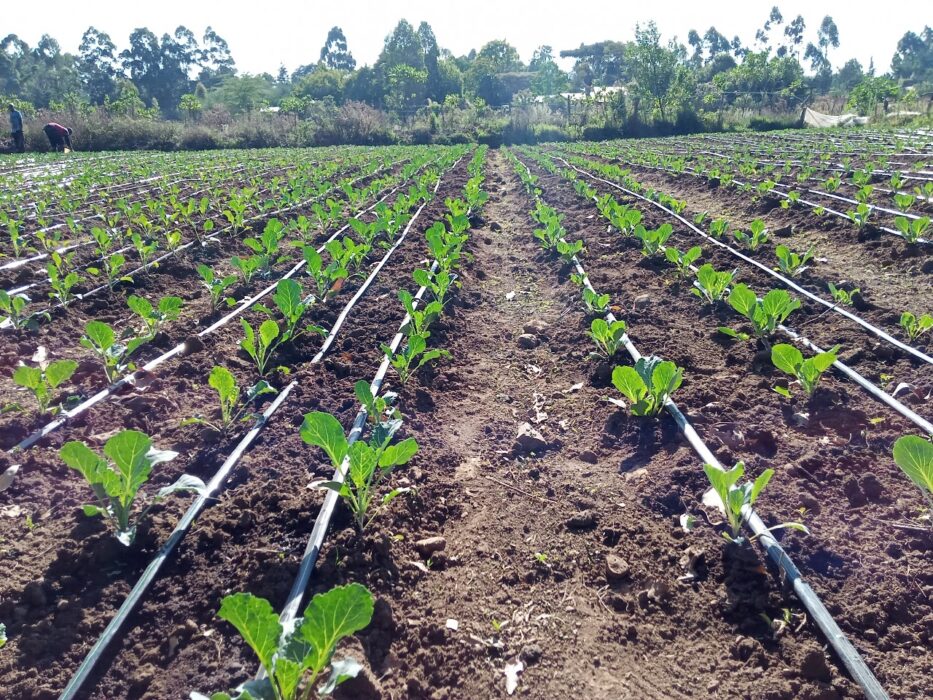
Drip Irrigation System Layout
Grekkon Limited’s drip irrigation system layout is done for all farm sizes, and all crops. There 3 ways in which the company gathers data to develop a drip irrigation system layout
- Farmers provide detailed sketches as directed by the company from which a drip irrigation system layout is developed. This sketch will include; the farm dimensions in meters, the water source type, distance to the water source from the farm, details of any existing irrigation infrastructure, any existing roads or pathsways, any none farmable sections (rocky areas, wet lands, built up locations etc), planting beds layout, the direction(s) of slope, and the total vertical elevation
- Provide the farm’s map coordinates from which the company assesses the farm layout using satellite technology
- Conduct a physcal site assessment visit. This is only carried when 2 above cannot be done
The company only charges for the 3rd service to cover the logistical costs


A sample drip irrigation system layout for a 40 acre farm by Grekkon Limited
The company’s irrigation engineers will conduct a physical visit on a prospective farm to determine the following
i. The water source. The company measures the water volume, and analysis the quality. The volume determines the irrigation system to use, the size of the water pump, and the acreage covered. For intance, a farmer with a borehole yielding 15 cubic litres per hour is best positioned to irrigate using drip irrigation. His irrigated acreage will not exceed 30 acres for optimal water utilisation. On the other hand, a farmer by a large permanent river or lake water source will irrigate hundreds of acres using any irrigation method preferred. The water quality determines the type of filtration system to install.
A screen filter is for water under low pressure with a negligible amout of suspended dirt or other particles. A disc filter is preferred for water under high pressure, with a negligible to a modest amount of suspended dirt orcother particles. A sand filter is for dirty water under high pressure

A simple drip irrigation kit by gravitational flow system layout
ii. The dimensions of the farm in meters. to provide the total acreage. The acreage will determine the pipe diameter sizes, the water pump’s flow rate, and the sub-division of the irrigation blocks
iii. Slope. The elevation of the farm gives the vertical head or lift needed. This is important in determining the pressure rating of the water pump to install, the pipe diameters, the planting beds layout (these should be done against the slope), and the size of the irrigation blocks
iv. Any existing irrigation infrastructure; to determine what can be used or incorporated into the new system
v. Provide advise on security measures for key company installations such as; large water pumps, solar modules, solar inverters, control panels, cables, and other high value accessories
Key Requirements To Install A Drip Irrigation System
1. A water source
2. A water pump and piping mechanism to move this water from the source to the tank or directly to the drip irrigation system.
3. Water storage tank if you’re using gravity to irrigate
4. A tank connector
5. Pipes for the mainline and sub-main line.
6. Mainline and sub mainline fittings
7. Drip irrigation water filter
8. Drip irrigation pipes
9. Accessories
10. Ball valves
Steps To Follow In Designing A Drip Irrigation Layout
- Determine where the water pump or water tank will be placed. Water tanks are used for small acreage gravity flow irrigation, and should be placed at highest elevation to allow ease of water flow by gravity
- The main line originates from the water tank or water pump. The size of the main line determines the volume of irrigation water delivered to the farm in every irrigation session. The larger the farm, the greater the diameter of the mainline
- The water filter is connected along the main line
- A venturi fertigation system where needed is along the main line. The venturi fertigation system is a chemifertigation centre that allows drenching of chemicals and fertiliser through the drip irrigation system
- The air release valves are along the main line. Air release valves are installed where the water pressure is high. This is in steep elevations, or if the water is chanelled via a high pressure water pump. They prevent air locks in the irrigation system. Air locks dramatically reduce, or cease water flow in the system
- A sub main line will be connected to the main line along its way using hydrants. Hydrants are points from which irrigation in a block is controlled from. They can be automated using solenoid valves, or manually operated through ordinary valves. The decision to have sub main lines is a factor of the farm size. In small drip irrigation set ups, the drip pips are directly connected to the main line. In larger acreage, the drip line originate from the sub mainline
- The main line is always larger in diameter than the sub main line. The diameter of the sub main line is determined by the size of the main line. The larger the latter, the larger the sub main line is
- The hydrants are positioned at the beginning or end of every irrigation block
- Planting beds are done against the slope. This is to slow down erosion, and allow better water percolation in the soil during the rainy season. The width of the planting bed is determined by the crop type
- Drip lines lie along the length of the planting beds. The number of drip lines per bed depends on the crop type. E.g 2 drip lines are installed for tomato, 3 drip lines for onion or garlic, and 4 drip lines for some herbs and spices

A 3 row drip layout per bed installed in Birikani area of Kajiado county
